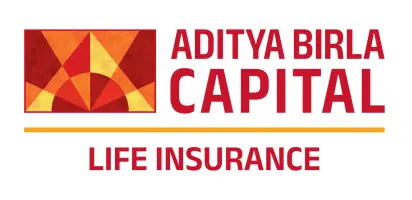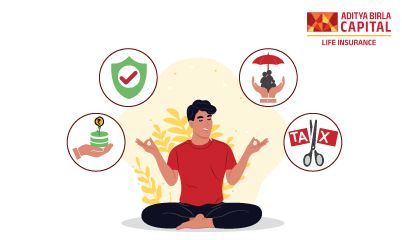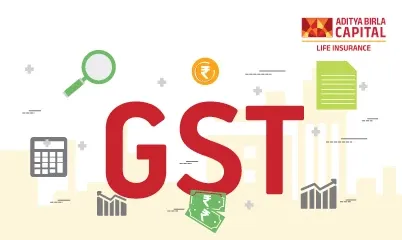Aditya Birla Sun Life Insurance Company Limited
What is the Income Tax Slab?
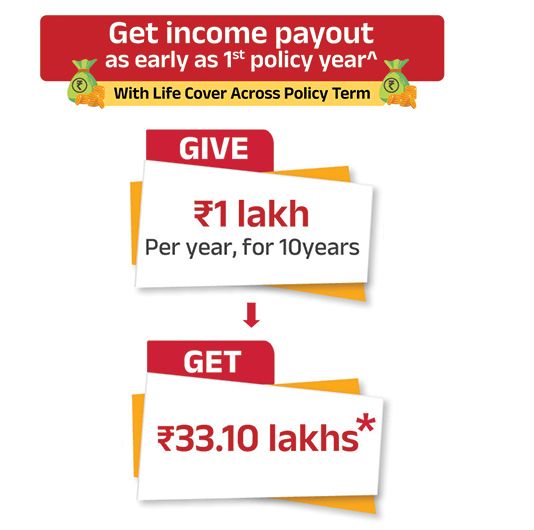
Plan Smarter, Live Better!

Thank you for your details. We will reach out to you shortly.

Currently we are facing some issue. Please try after sometime.
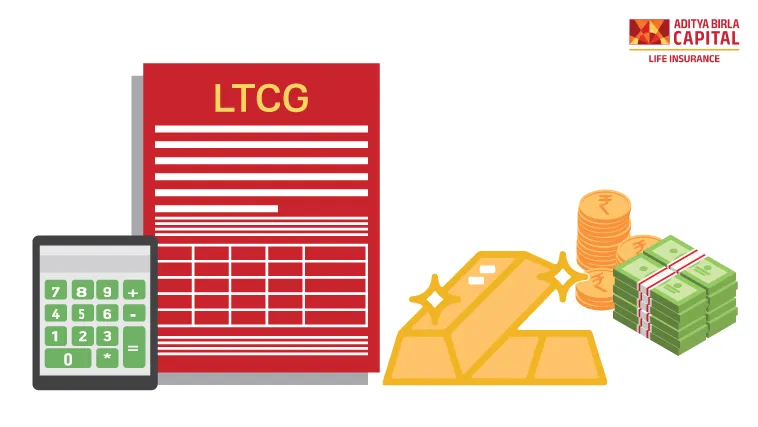

- Table of Contents
In February 2021, the Finance Minister of India, Nirmala Sitharaman, addressed the new tax regime that would soon revolutionize the income tax slab layout that the citizens of India know of today. The constant upgrades to the Indian tax system has contributed to active puzzlement surrounding its revision. To aid you in your understanding of the current income tax slab, we provide you with the following information on it.
The Income Tax Slab
Based on a tax slab system, tax is levied on individual taxpayers in India. Each slab is associated with a different tax rate being applied to a different income range. Any increase in the income of a taxpayer directly increases the tax rate for that income value. This progressive tax system ensures that every individual is taxed appropriately based on their income level. Further, tax rates vary as per the 'individual taxpayer' categorization one falls into. The tax brackets for the three classifications are detailed below. It must be borne in mind, however, that individuals and Hindu undivided families (HUF) have the option to opt for either the old or new tax regime.
| Classification: Resident and Non-Resident Individuals (less than 60 years) | |
| Income | Tax |
| Up to Rs. 2.5 lakhs | Exempted |
| Rs. 2.5 lakhs to Rs. 5 lakhs | 5% of income above Rs. 2.5 lakhs |
| 5 lakhs to 10 lakhs | 20% of income above Rs. 5 lakhs and Rs. 12,500 as rebate |
| Above Rs. 10 lakhs | 30% of income above Rs. 10 lakhs and Rs. 112,500 as rebate |
| Classification: Resident Senior Citizens (60 to 80 years) | |
| Income | Tax |
| Up to Rs. 3 lakhs | Exempted |
| Rs. 3 lakhs to Rs. 5 lakhs | 5% of income above Rs. 3 lakhs |
| 5 lakhs to 10 lakhs | 20% of income above Rs. 5 lakhs and Rs. 10,000 |
| Above Rs. 10 lakhs | 30% of income above Rs. 10 lakhs and Rs. 1,10,000 |
| Classification: Resident Super Senior Citizens (greater than 80 years) | |
| Income | Tax |
| Up to Rs. 5 lakhs | Exempted |
| 5 lakhs to 10 lakhs | 20% of income above Rs. 5 lakhs |
| Above Rs. 10 lakhs | 30% of income above Rs. 10 lakhs and Rs. 1,00,000 |
Exemptions, Deductions, and their Implications
One of the major benefits of the old tax system was the level of tax liability it offered every individual. These benefits were complimented by the high tax rates that dictated how much of a person's income could be spent. Deductions were one of the most crucial aspects of the old system's foundation as it offered individuals the ability to save, invest and complete transactions while lowering any tax burden. The most significant tax deduction goes up to Rs. 1.5 lakhs under Section 80C.
According to the rules under the new tax regime, an individual has to make a decision on whether they wish to abide by the old income tax slab or whether they prefer to utilize the lower tax rates provided to them by foregoing some tax exemptions. Common deductions and exemptions to be foregone by a salaried individual under the new regime include:
- Leave travel allowance
- House rent allowance: Salary and rent expense dependent
- Conventional deduction: Rs. 50,000 under Section 16 of the Income Tax Act
- Section 80C deduction: Up to Rs. 150,000
- Section 24 deduction: Up to Rs. 200,000 on interest on loan
- Savings bank interest: Up to Rs. 10,000 covered by Section 80TTA
- Interest income: Up to Rs. 50,000 for senior citizens covered by Section 80TTB
- Medical insurance premium: Up to Rs. 25,000 and Rs. 50,000 for parents and senior citizens
- Entertainment allowance: Provision available only for government employees covered by Section 16
- Interest on educational loan: Covered by Section 80E for eight successive years
- Medical treatment: Usually up to Rs. 40,000 (self or dependent) and Rs. 1 lakh for senior citizens. For the treatment of any disability, it is up to Rs. 75,000 to Rs. 125,000 (self or dependent) under Sections 80DDB and 80D.
The New Income Tax Regime
Under the new regime, the income tax rates vary for different categories of people and different kinds of corporations.
Under the new regime, the income tax rates vary for different categories of people and different kinds of corporations.
- Partnership firms: The taxable income for a partnership firm is 30% with a surcharge of 12% if aggregate income exceeds Rs. 1 crore
-Local authorities: The taxable income for a local authority is 30% with a surcharge of 12% if aggregate income exceeds Rs. 1 crore.
- Association of persons (AOP) or body of individuals (BOI): If your taxable income is up to Rs. 250,000, a tax rate does not apply to your income. If, on the other hand, your taxable income is between Rs. 2.5
lakhs and Rs. 5 lakhs, the interest rate calculated on your income will be 5%. This tax rate rises to 20% and then 30% if your income is between Rs. 5 lakhs to Rs. 10 lakhs and above Rs. 10 lakhs, respectively.
The surcharge structure under BOIs and AOPs start from 10% when income exceeds Rs. 50 lakhs, 15% when income exceeds Rs. 1 crore, 25% when income exceeds Rs. 2 crore and 37% when income exceeds Rs. 5 crores.
| Income Slab | ||
| Income Level | Existing Effective Tax Rate (Surcharge + Cess) | Proposed Effective Tax Rate (Surcharge + Cess) |
| Up to 250,000 | Nil | Nil |
| 250,001 –500,000 | Nil (after rebate under section 87A) | 5.2% |
| 500,001 –750,000 | 20.8% (4% education cess thereon) | 10.4% |
| 750,001 –1,000,000 | 20.8% (4% education cess thereon) | 15.6% |
| 1,000,001 –1,250,000 | 31.2% (4% education cess thereon) | 20.8% |
| 1,250,001 –1,500,000 | 31.2% (4% education cess thereon) | 26% |
| 1,500,000 –5,000,000 | 31.2% (4% education cess thereon) | 31.2% |
| 5,000,001 –10,000,000 | 34.32% (10% education cess thereon) | 34.32% |
| 10,000,001 –20,000,000 | 35.88% (15% education cess thereon) | 35.88% |
| 20,000,001 –50,000,000 | 39% (25% education cess thereon) | 39% |
| 50,000,001 and above | 42.744% (37% education cess thereon) | 42.74% |
An Example
Let's understand the difference between the two income tax systems with the help of an example.
Let's understand the difference between the two income tax systems with the help of an example.
- Rania earns a basic salary of Rs. 100,000 per month, a housing rent allowance of Rs. 50,000 per month and leave travel allowance of Rs. 20,000 annually.
| Particulars | Income | Taxable Income under Old Regime | Taxable Income under New Regime |
| Salary | 1,200,000 | 1,200,000 | 1,200,000 |
| Housing Rent Allowance | 600,000 | 240,000 (360,000 gets exempted) | 600,000 |
| Leave Travel Allowance | 20,000 | 8,000 (12,000 gets exempted) | 20,000 |
| Deduction | 50,000 | Not Applicable | |
| Salary after Tax Changes | 1,398,000 | 1,820,000 |
It must be noted that in case an individual or HUF opts for the lower tax regime, certain exemptions, deductions and set-off of losses will not be available to be considered while computing the taxable income (certain instances given below):
- LTC/ assistance under Section 10(5);
- HRA under section 10(13A);
- Specific allowances under section 10(14) to be prescribed;
- Standard deduction, professional tax deduction under section 16;
- Interest paid on housing loan under section 24(b) on self-occupied property and loss under the head “house property”;
- Exemption not exceeding INR 1,500 in respect of income of minor child under section 10(32);
- Specified expenditure or deductions that could be claimed while computing profits and gains from business and profession;
- Deduction from income from other source under section 57 for family pension;
- Deductions under Chapter VIA other than deduction in respect of employers contribution to NPS under section 80CCD(2).
National Pension Scheme (NPS)
Both private citizens and government employees can avail the benefits of such a retirement scheme. Money accumulated through the NPS is invested in various avenues including the equity markets and other securities. The reason behind its popularity is because the benefits are high while the investment options are cheap with the added provision of access to the equity market. The only worrisome feature of this account is the lack of assurance it provides in terms of earning steady returns because of its direct linkage with market performance. However, this worrisome feature is immediately trumped once an individual learns that NPS is one of the higher return-offering schemes available for investments.
Under Section 80CCD, income tax deductions are offered to those individuals who have initiated the NPS. Until 2015, individuals redeemed deductions up to Rs. 1 lakh for their contributions to the NPS. In 2015, however, the Indian government maximized the amount payable to the NPS up to Rs. 1.5 lakhs per annum. Eventually, Section 80CCD(1B) was introduced to provide supplementary deductions up to Rs. 50,000 for those citizens that contributed to the NPS.
New vs Old Income Tax Regime
| Pros of New Tax Regime | Pros of Old tax Regime |
| Flexibility: With certain deductions being eliminated, investments can be made anywhere to avail exemptions, thereby, allowing an individual to exercise flexibility over their investment avenues. | Increased Savings: Making it mandatory to invest in different avenues led to an increase in investments and increased an individual's financial stability. |
| Convenience: As most of the deductions have been removed, tax filing and overall documentation processes have become quicker in the tax department. | Saving Rate Contributor: India's gross savings rate was only 30% in March 2019. As an individual's savings increased, the overall saving rate improved. |
| Increased Liquidity: Reduced tax rates lead to higher disposable income at a taxpayer's disposal. | |
| Fairness: Allowances will no longer stand as a criterion to redeem any tax exemption. This, in turn, benefits those individuals who cannot afford to make any investments because of the lock-in periods that follow such investments. |
Thank you for your details. We will reach out to you shortly.
Thanks for reaching out. Currently we are facing some issue.
Buy ₹1 Crore Term Insurance at Just ₹575/month1
ABSLI DigiShield Plan
Life cover up to 100 years of age.
Joint Cover Option
Inbuilt Terminal Illness Benefit
Tax Benefit^
Return of Premium Option~
Life Cover
₹1 crore
Premium:
₹575/month1
Most Popular Calculator
Guaranteed returns after a month¹
ADV/3/20-21/2693
